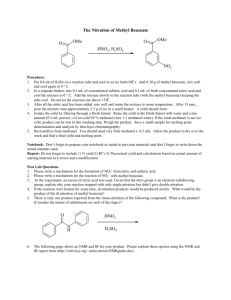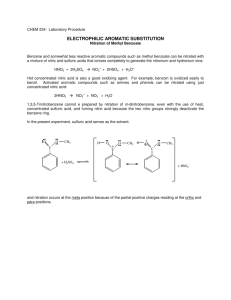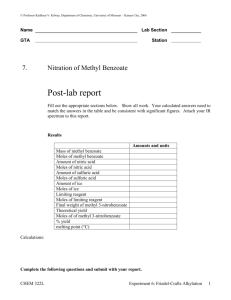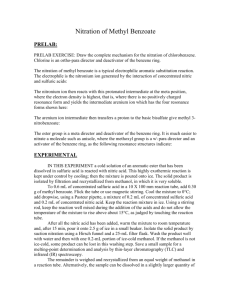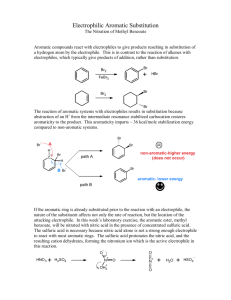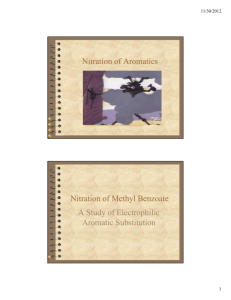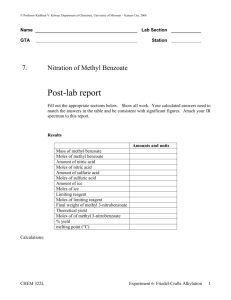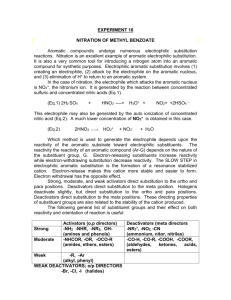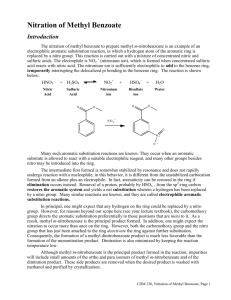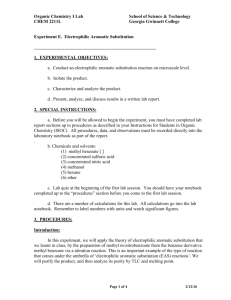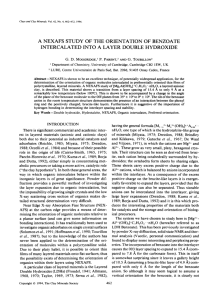7. Nitration of Methyl Benzoate - Web Pages
advertisement
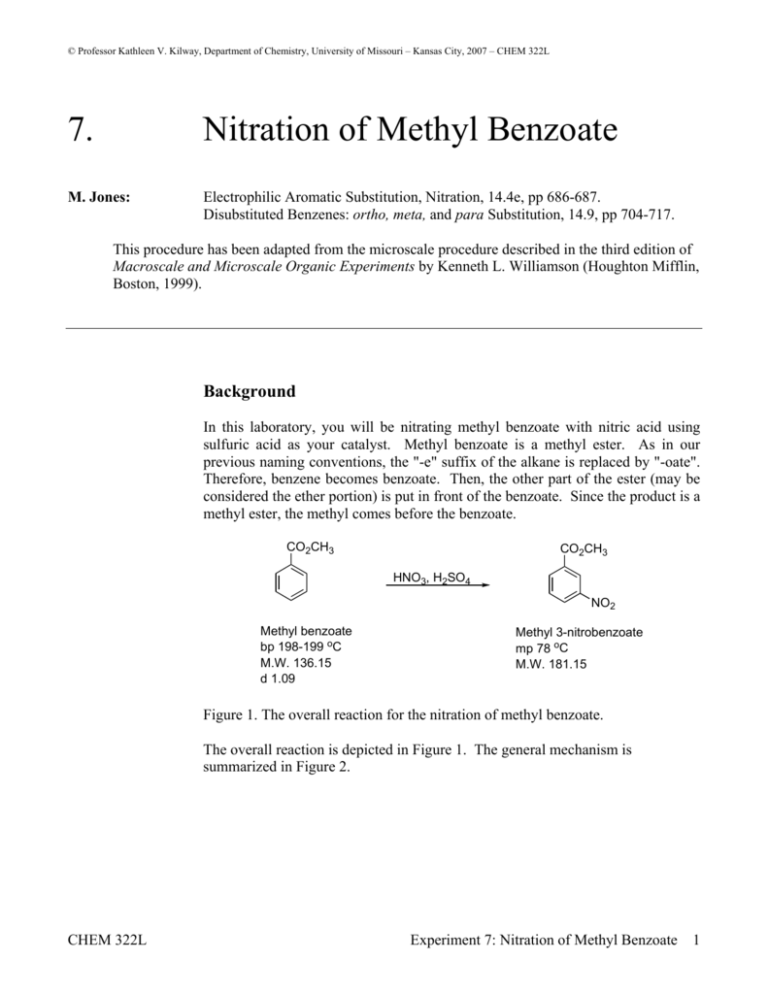
© Professor Kathleen V. Kilway, Department of Chemistry, University of Missouri – Kansas City, 2007 – CHEM 322L 7. Nitration of Methyl Benzoate M. Jones: Electrophilic Aromatic Substitution, Nitration, 14.4e, pp 686-687. Disubstituted Benzenes: ortho, meta, and para Substitution, 14.9, pp 704-717. This procedure has been adapted from the microscale procedure described in the third edition of Macroscale and Microscale Organic Experiments by Kenneth L. Williamson (Houghton Mifflin, Boston, 1999). Background In this laboratory, you will be nitrating methyl benzoate with nitric acid using sulfuric acid as your catalyst. Methyl benzoate is a methyl ester. As in our previous naming conventions, the "-e" suffix of the alkane is replaced by "-oate". Therefore, benzene becomes benzoate. Then, the other part of the ester (may be considered the ether portion) is put in front of the benzoate. Since the product is a methyl ester, the methyl comes before the benzoate. CO2CH3 CO2CH3 HNO3, H2SO4 NO2 Methyl benzoate bp 198-199 oC M.W. 136.15 d 1.09 Methyl 3-nitrobenzoate mp 78 oC M.W. 181.15 Figure 1. The overall reaction for the nitration of methyl benzoate. The overall reaction is depicted in Figure 1. The general mechanism is summarized in Figure 2. CHEM 322L Experiment 7: Nitration of Methyl Benzoate 1 Step 1 - generation of the electrophile HO NO2 + H OH2 H2O O N O + H2O + H2O Step 2 - nucleophilic attack by arene to the electrophile H H O O N N O H O H O N O H NO2 NO2 H H Step 3 - regeneration of catalyst H H2O NO2 NO2 + H3O+ H Figure 2. The generic nitration mechanism. The only difference from what has been discussed in the lecture portion of the class is the protonation of the ester in strong acid. There is always an equilibrium between the protonated C=O of the ester and not. This structure explains even more so why an ester is considered an EWG and the placement of the product. O OCH3 H O OCH3 strongly acidic conditions Figure 3. Protonation of the ester group. Cautions: - Make sure to wear old, unimportant clothes (and proper shoes), and make sure to pull hair back. - Take extra care when handling concentrated nitric and sulfuric acid. - Make sure to use a clean spatula, filter flask, and reaction tube. The reaction tubes should be cleaned with soap, water and a brush first, rinsed thoroughly, and dried (if needed rinse with acetone). - Make sure to return the top to the bottles. - Do not return unused chemicals and reagents to the original bottles. CHEM 322L Experiment 7: Nitration of Methyl Benzoate 2 Experiment Add 1.0 mL of concentrated sulfuric acid to a large reaction tube and place the tube in an ice water bath. Add 0.4 mL of methyl benzoate. Carefully add 0.5 mL of concentrated sulfuric acid and 0.5 mL of concentrated nitric acid to a small vial, which has been cooled in ice. Add this acidic mixture dropwise to the large reaction tube. Stir after each drop. After the addition is complete, remove the tube from the ice water bath and let it warm to room temperature. While warming, use a glass stirring rod to gently mix your sample, which should be a yellow, homogeneous mixture. If two layers form or the mixture is oily, add a small amount of sulfuric acid. When the mixture has reached room temperature, let it stand for an additional 15 minutes. After this time period, pour the mixture into a 50 mL beaker that contains ice to the 10 mL mark. As the ice dissolves, a white precipitate will form. Vacuum filter to collect the solid. Wash the solid well with water. The solid is then recrystallized from methanol or methanol/water (if necessary). For this lab, report your percent yield and melting point. Also, record your observations of your starting materials and product. Take an IR spectrum of your product using methylene chloride as the solvent. Assign the stretches. CHEM 322L Experiment 7: Nitration of Methyl Benzoate 3
